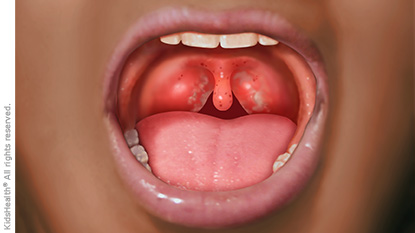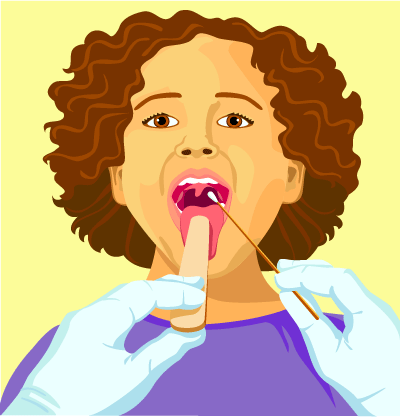Strep Test: Throat Culture
Article Translations: (Spanish)
What It Is
A throat culture or strep test is performed by using a throat swab to detect the presence of group A streptococcus bacteria, the most common cause of strep throat. These bacteria also can cause other infections, including scarlet fever, abscesses, and pneumonia.
A sample swabbed from the back of the throat is put on a special plate (culture) that enables bacteria to grow in the lab. The specific type of infection is determined using chemical tests. If bacteria don't grow, the culture is negative and the person doesn't have a strep throat infection.
Strep throat is a bacterial infection that affects the back of the throat and the tonsils, which become irritated and swell, causing a sore throat that's especially painful when swallowing. White or yellow spots or a coating on the throat and tonsils also might be present, and the lymph nodes along the sides of the neck may swell.

Strep throat is most common among school-age children. The infection may cause headaches, stomachaches, nausea, vomiting, and listlessness. Strep throat infections don't usually include cold symptoms (such as sneezing, coughing, or a runny or stuffy nose).
While symptoms of strep throat can go away within a few days without direct treatment, doctors will prescribe antibiotics to help prevent related complications that can be serious, such as rheumatic fever. Taking antibiotics reduces the length of time a person is contagious.
Why It's Done
The throat culture test can help find the cause of a sore throat. Often, a sore throat is caused by a virus, but a throat culture will see if it's definitely caused by strep bacteria, helping doctors decide on the proper treatment.
Preparation
Encourage your child to stay still during the procedure. Be sure to tell the doctor if your child has taken any antibiotics recently, and try to have your child avoid antiseptic mouthwash before the test as this could affect test results.
The Procedure
A health professional will ask your child to tilt his or her head back and open his or her mouth as wide as possible. If the back of the throat cannot be seen clearly, the tongue will be pressed down with a flat stick (tongue depressor) to provide a better view. A clean, soft cotton swab will be lightly brushed over the back of the throat, over the tonsils, and over any red or sore areas to collect a sample.
You may wish to hold your child on your lap during the procedure to prevent movement that could make it difficult for the health professional to obtain an adequate sample.

What to Expect
Your child may have some gagging when the swab touches the back of the throat. If your child's throat is sore, the swabbing may cause brief discomfort.
Getting the Results
Throat culture test results are generally ready in 2 days.
Risks
Throat swabbing can be uncomfortable, but no risks are associated with a throat culture test.
Helping Your Child
Explaining the test in terms your child can understand might help ease any fear. During the test, encourage your child to relax and stay still so the health professional can adequately swab the throat and tonsils.
If You Have Questions
If you have questions about the throat culture strep test, speak with your doctor.
Note: All information is for educational purposes only. For specific medical advice, diagnoses, and treatment, consult your doctor.
© 1995-2024 KidsHealth ® All rights reserved. Images provided by iStock, Getty Images, Corbis, Veer, Science Photo Library, Science Source Images, Shutterstock, and Clipart.com

